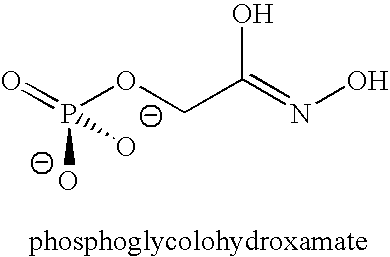Methods for indentifying compounds that modulate an enzyme involved in riboflavin metabolism in a pathogenic microorganism
a technology of riboflavin metabolism and indentification compounds, which is applied in the direction of phosphorous compound active ingredients, heterocyclic compound active ingredients, biocide, etc., can solve the problems of affecting the activity of the organism, and achieve the effect of inhibiting the activity
- Summary
- Abstract
- Description
- Claims
- Application Information
AI Technical Summary
Benefits of technology
Problems solved by technology
Method used
Image
Examples
example 1
Aldolase
1. Description of Relevant Pathway(s)
[0058] Glycolysis is the primary pathway for anaerobic degradation of D-glucopyranoses and other D-hexopyranoses. It is probably universal among organisms: certainly the enzymes which catalyze the pathway's reactions are among the most conserved (and therefore presumably most ancient) among proteins. The process is a series of consecutive chemical conversions that require the participation of eleven different enzymes, most of which have been crystallized and thoroughly studied. Glycolysis begins with a single molecule of glucose and concludes with the production of two molecules of pyruvic acid. The pathway is seen to be degradative, or catabolic, in that the six-carbon glucose is reduced to two molecules of the three-carbon pyruvic acid. Much of the energy that is liberated upon degradation of glucose is conserved by the simultaneous formation of the high-energy molecule adenosine triphosphate (ATP). Two reactions of the glycolytic se...
example 2
Coenzyme A(CoA)
1. Description of Relevant Pathway(s)
[0096] Coenzyme A (CoA) is an essential coenzyme in a variety of reactions that sustain life. CoA is required for chemical reactions that generate energy from food (fat, carbohydrates, and proteins). The synthesis of essential fats, cholesterol and steroid hormones requires CoA, as does the synthesis of the neurotransmitter, acetylcholine, and the hormone, melatonin Heme, a component of hemoglobin, requires a CoA-containing compound for its synthesis. Metabolism of a number of drugs and toxins by the liver requires CoA.
[0097] Coenzyme A was named for its role in acetylation reactions. Most acetylated proteins in the body have been modified by the addition of an acetate group that was donated by CoA. Protein acetylation affects the 3-dimensional structure of proteins, potentially altering their function. Protein acetylation affects the activity of peptide hormones and appears to play a role in cell division and DNA replication. ...
example 3
Biotin
1. Description of the Relevant Pathway(s)
[0128] Biotin, a water soluble vitamin biosynthesized by plants and some bacteria and fungi is an essential protein and covalently bound cofactor used in carboxylation reactions central to human metabolism, including enzymes involved in fatty acid biosynthesis, gluconeogenesis, and branched-chain amino acid catabolism. Biotin synthase catalyzes the terminal step in biotin biosynthesis via the insertion of a sulfur atom between C6 and C9 of the precursor dethiobiotin, forming the biotin thioether ring. This insertion reaction is deceptively simple yet represents an impressive feat of enzymatic catalysis, requiring the enzyme break two saturated, unactivated CH bonds in dethiobiotin prior to sulfur insertion. This reaction is catalyzed by the E. coli BioB protein, a dimeric iron-sulfur protein, and requires the participation of AdoMet and reduced flavodoxin, indicating that biotin synthase is a member of a family of enzymes that reduct...
PUM
| Property | Measurement | Unit |
|---|---|---|
| energy | aaaaa | aaaaa |
| conformational state | aaaaa | aaaaa |
| resistance | aaaaa | aaaaa |
Abstract
Description
Claims
Application Information
 Login to View More
Login to View More - R&D
- Intellectual Property
- Life Sciences
- Materials
- Tech Scout
- Unparalleled Data Quality
- Higher Quality Content
- 60% Fewer Hallucinations
Browse by: Latest US Patents, China's latest patents, Technical Efficacy Thesaurus, Application Domain, Technology Topic, Popular Technical Reports.
© 2025 PatSnap. All rights reserved.Legal|Privacy policy|Modern Slavery Act Transparency Statement|Sitemap|About US| Contact US: help@patsnap.com



